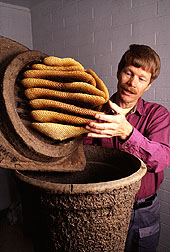Bee Traps Go Commercial
|
|
Inexpensive traps developed at the Carl Hayden Bee Research Laboratory in Tucson, Arizona, are now being used commercially to capture honey bee swarms that might otherwise take up residence in homes or too near schools, playgrounds, and parks.
"And Africanized honey bees pose even more of a problem," says Steve Thoenes of Bee Masters in Tucson. "They produce more swarms and are more defensive, once they have set up a new hive."
His company, for a monthly fee, uses traps to protect areas such as the Desert Museum, Tucson International Airport, and local resort golf courses.
Thoenes assisted Agricultural Research Service entomologist Justin O. Schmidt in developing the traps in 1987-89 at the Tucson lab. Schmidt also developed the chemical lure that when placed inside the traps, attracts bee swarms.
|
|
"We originally developed the traps and lure to give advance warning that Africanized honey bees are present in an area and that special care must be exercised to ensure they are not disturbed," says Schmidt. "Our lab tests showed that the traps can attract up to 90 percent of the bee swarms that migrate from their home or colony.
"In 1994, only 15 percent of the trapped swarms were Africanized. So far this year, almost 90 percent are this strain," says Thoenes.
He places traps strategically, where bees are likely to first appear, and then he monitors them. When a bee swarm has set up housekeeping in a trap, he covers the entrance and removes both the swarm and the trap. Then he puts a new trap in its place.
Both the traps and lure are being manufactured commercially.
"We are selling the traps and lures internationally—everywhere there is agriculture—to both hobbyists and commercial beekeepers," says Jack Thomas of Mann Lake, Ltd., in Hackensack, Minnesota.
Thomas says he originally learned of them by reading one of Schmidt's scientific publications.
Scientists first constructed the traps from pots commonly used in plant nurseries. The pressed wood pulp pots contain an asphalt derivative for strength and an antifungal agent to inhibit decomposition. They last for about 2 years in warm, moist environments—longer in drier climates. Commercial traps today are similar.
Scientists at the Tucson lab are now testing the traps in Puerto Rico to monitor Africanized honey bee movements. To the untrained eye, Africanized bees are indistinguishable from their European cousins that have been in this country since the early 18th century. Only an expert can tell this more defensive strain from bees used commercially to annually pollinate some $10 billion worth of agricultural crops.
Africanized honey bees, descendants of bees imported from Africa to Brazil, have migrated north from South America since 1957. [See also "Buzzing Across the Border," Agricultural Research, March 1996, p. 4.] The first swarms arrived in Texas in October 1990 and have now spread into New Mexico, Arizona, and California. -- By Dennis Senft, ARS.
Justin O. Schmidt is at the USDA-ARS Carl Hayden Bee Research Laboratory, Tucson, AZ; phone (520) 670-6380 ext. 109.








